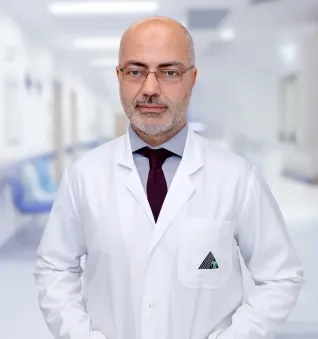Alo Yeditepe
Alo Yeditepe
If the Size of the Thyroid Nodule is Over 4 cm, Be Cautious!
Endocrine Surgeon Prof. Dr. Erhan Ayşan, who emphasizes that thyroid cancer can be detected through ultrasound rather than blood tests, issued warnings regarding the size of nodules that cause cancer. Prof. Dr. Ayşan stated, "As the nodule size increases, the risk of cancer also increases. The critical value here is 4 cm, and if the nodule size reaches 4 cm, the patient should undergo surgery without fail because there is a risk of cancer."
The number of individuals diagnosed with thyroid cancer is increasing every year in Turkey, a country endemic to endemic goiter. Prof. Dr. Erhan Ayşan, an Endocrine Surgery Specialist at Yeditepe University Koşuyolu Hospital, pointed out that surgery is always necessary in every case of thyroid cancer and made important statements about the increasing frequency of thyroid cancer.
Prof. Ayşan emphasized that the number of nodules is also important in terms of cancer risk in thyroid cancer, stating that as the number of nodules increases, the risk of cancer does not increase but rather decreases.
"Genetic Heritage and Geography are the Most Important Causes of Thyroid Cancer"
Prof. Dr. Erhan Ayşan, stating that there is a principle in thyroid cancer that "if there are no nodules, there is no cancer," emphasized the importance of nodules. He pointed out that thyroid cancer and nodules are frequently observed in Turkey, and therefore, as the incidence of nodules increases, the incidence of cancer also increases.
While there are several risk factors in thyroid cancer, Prof. Dr. Erhan Ayşan emphasized that the most important factors are our genetic codes inherited from our families and our geography. He provided the following information on the subject: "The Black Sea and Eastern Anatolia regions of our country are mountainous areas, where thyroid cancer is frequently observed. Another factor we can mention is the Chernobyl disaster. The traces of Chernobyl are still present in our country; we experienced Chernobyl in the 1980s, but genetic damage like this manifests itself 20-30 years later. It should not be forgotten that genetic factors play a significant role in thyroid cancer. Thyroid cancer is frequently observed genetically in our country. Since thyroid cancer is a disease with genetic inheritance, we can see this disease in generations."
"After the Age of 40, the First Thyroid Ultrasound Should Be Performed Without Fail”
Prof. Dr. Erhan Ayşan emphasizes that scientific research on cancer frequency looks at 5-year periods. He states, "Analyses reveal that thyroid cancer is observed more frequently in our country every 5 years compared to the previous 5 years. We observe these values in our clinics, outpatient departments, and patient examinations. As long as the existing factors continue, the frequency of thyroid nodules and cancer will increase.
" Prof. Dr. Erhan Ayşan highlights that when individuals get their thyroid hormone levels checked and the results come back normal, they tend to develop a mindset of "I don't have cancer." However, he emphasizes the need to change this misconception and explains, "It should be known that thyroid cancer does not appear in blood tests. The most valuable diagnostic tool we have for thyroid cancer is ultrasound. Sometimes, we can diagnose thyroid cancer by examining ultrasound data without even performing a biopsy. Therefore, in a country like Turkey where thyroid cancer is frequently observed, it is essential for people to undergo neck ultrasound examinations. The first thyroid ultrasound should be done after the age of 40. Based on the obtained data, we recommend continuing thyroid ultrasound examinations on an annual or 5-year basis, depending on the frequency."
“As the Number of Nodules Increases, the Risk of Cancer Decreases”
"People tend to think that as the number of nodules increases, the likelihood of cancer also increases. However, Prof. Dr. Ayşan indicates that the opposite is true, and as the number of nodules increases, the risk of cancer actually decreases," continues Prof. Dr. Ayşan. He further explains, "As physicians, when we see multiple nodules on an ultrasound, we feel relieved. On the other hand, when one or two nodules are observed, the possibility of cancer increases. However, it should also be noted that only 5% of thyroid nodules are cancerous, while 95% are non-cancerous. Unfortunately, individuals who are diagnosed with a thyroid nodule often jump to the conclusion that they have cancer. This is a misconception. If you have a nodule, don't worry, but don't neglect seeking advice from a specialist."
“The Patient Must Undergo Surgery if the Nodule Size Reaches 4 cm”
Prof. Dr. Erhan Ayşan emphasizes that as the size of a nodule increases, the risk of cancer also increases. He points out that the critical value is 4 cm, and if the nodule size reaches 4 cm, the patient should undergo surgery without fail. This is because when the nodule reaches this size, the cells within the nodule start to differentiate and become uncontrolled, significantly increasing the risk of cancer. At this point, biopsy or follow-up no longer serves a purpose. Patients with a thyroid nodule measuring 4 cm or larger should undergo surgery without undergoing biopsy or follow-up. If surgery is not performed, the progression to cancer becomes inevitable. Moreover, as the nodule size increases, the surgical procedure becomes more difficult and the incisions become larger. Patients with small nodules can undergo a less risky surgery with a small incision and stay in the hospital for one night, returning home the next day. However, if the nodule grows and becomes cancerous, there is a risk of lymph node involvement, larger surgeries with wider incisions, radioactive iodine treatment, and the risk of metastasis.
“Thyroid Cancer Progresses Insidiously”
Yeditepe University Koşuyolu Hospital's Endocrine Surgery specialist, Prof. Dr. Erhan Ayşan, emphasizes that thyroid cancer is a disease that progresses insidiously. He stated that even individuals with nodules measuring 6-7 cm may not exhibit any symptoms, as this disease often does not present noticeable signs. Therefore, he highlights the importance of regular check-ups. Prof. Dr. Ayşan continued by saying, "Nodules often grow towards the muscles in the neck, and in such cases, no abnormalities can be observed from the outside, regardless of the size of the nodule. Occasionally, symptoms such as hoarseness, difficulty swallowing, choking sensation, or constriction in the throat may be experienced, although they are rare. There are also concepts of internal goiter and external goiter. To make it easy to understand, we can illustrate them as follows: imagine a ping pong ball with a size of 4 cm. If you have a swelling in your neck the size of a ping pong ball, it may go unnoticed, and we call this internal goiter. Sometimes, if a tiny nodule is located on the surface, it can be easily noticed from the outside, and we call this external goiter. So, even during a conversation with a friend who has an external goiter, you may notice their nodule. The problem with internal goiter is that since the nodule grows inward, it is not visible from the outside, and as it does not cause symptoms, it continues to grow day by day."
About
Faculty and Year of Graduation:
Istanbul University, Cerrahpasa Faculty of Medicine, 1994
”
See Also
- What is a Parathyroid Adenoma? Symptoms and Treatment
- What is Calcitonin Hormone? Calcitonin Hormone Deficiency
- How Does High Calcium in Blood Cause Complaints?
- A First in the Literature: Parathyroid Cell Obtained from Thyroid Stem Cell
- Diagnosis in Thyroid Diseases
- Assessment of Hyperthyroidism
- Hashimoto's Thyroid Disease
- Thyroid Tumor (Cancer)
- Graves' Disease
- Thyroid Nodules
- Thyroid Surgery
- Assessment of Hypothyroidism
- What is the Harm of High Calcium in the Blood?
- Frequently Asked Questions in Thyroid Diseases
- Atomic Therapy (Radioactive Iodine Therapy)
- Which Thyroid Nodule Can Be Treated Without Surgery?
- She Was Relieved of Her Pain When the Missing Parathyroid Gland Was Found in The Chest Cavity
- Thyroid Storm Can Turn Life Upside Down
- Recovered From Thyroid Nodule with Needle Melting Method
- Stress Triggers Thyroid Diseases; These Occupations Are At Risk!
- Turkish Physician Developed a Novel Method for Parathyroid Transplant
- What Should Be Considered After Parathyroid Surgery?
- Parathyroid Diseases and Treatment
- They Said It Was Thyroid Cancer, But It Turned Out to Be Parathyroid Adenoma!
- The Frequency of Thyroid Nodules and Thyroid Cancer in Young People is Increasing!
- Thyroid Cancer Treatment Is Possible Without Removing The Entire Thyroid Gland
- Thyroid Storm
- T4 Hormone in 13 Headings
- Questions About Thyroid Diseases
- Thyroid Diseases
- Goiter (Thyroid Gland) Biopsy
- Radiofrequency Therapy in Thyroid Nodules
- What Is Autoimmune Hypoparathyroidism or Hypocalcemia?
- What Is The Loss of Low Calcium Level in Blood?
- What Is The Symptoms of Calcium Level Elevation (Hypercalcemia)?
- How It Is Made The Parathyroid Adenoma Operation?
- What Is Parathyroid Hyperplasia?
- Parathyroid Tumors
- What Are The Parathyroid Glands?
- The Incidence of Thyroid Cancer Has Increased! There is Turkey in the Research!
- Key Surgery Performed In Turkish Hospital For First Time
Alo Yeditepe





